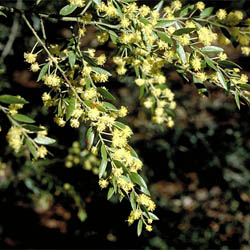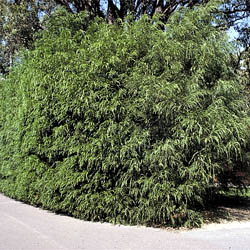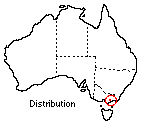Acacia howittii
 |
 |
Howitts Wattle, Sticky Wattle
It may seem surprising that Acacia howittii is such a hardy and quick grower in cultivation and yet is on the list of rare species of Australian plants. However, in its natural habitat this plant is restricted to a portion of the southern Gippsland hills, between Yarram and Tarra Valley in Victoria, a distance of only 20 km. It is not, however, considered to be under any threat. Indeed, A. howittii has been recorded to escape cultivation and occur as a weed* of bushland in south-eastern Australia and consideration should thus be given to its potential for invasiveness.
 It
is a graceful large shrub or small tree of dense, weeping habit reaching a height
of 5-8 m. The dark green phyllodes are 1-2 cm long and slightly sticky, hence
the common name of Sticky Wattle. This stickiness is especially noticeable when
the tree is being pruned. It responds well to hard pruning and specimens in
the Australian National Botanic Gardens, restricted to a height of 1 m, thickened
up so rapidly that they formed an ideal hedge plant.
It
is a graceful large shrub or small tree of dense, weeping habit reaching a height
of 5-8 m. The dark green phyllodes are 1-2 cm long and slightly sticky, hence
the common name of Sticky Wattle. This stickiness is especially noticeable when
the tree is being pruned. It responds well to hard pruning and specimens in
the Australian National Botanic Gardens, restricted to a height of 1 m, thickened
up so rapidly that they formed an ideal hedge plant.
In the Gardens the species has been used as a screen plant and one stand of seven plants (since removed) used for screening an amenities block on the Eucalyptus lawn gained the admiration of visitors. The trees were planted at 2 m spacings and after 10 years formed a dense wall 3 m high. This height is maintained by cutting the tops back 2 m each year.
The flowers are pale yellow balls appearing in spring. The fruiting pods which follow are 4-6 cm long and 5 mm wide.
Propagation is from scarified seed with germination generally taking between sixteen and eighteen days under ideal seed-raising conditions in the Botanic Gardens nursery. Recently, however, good results have been obtained by directly sowing the pre-treated seed into pots of a friable, sandy mix. Although germination has been slower, taking up to one month, the intermediate stage of pricking out is avoided and thus no setback is caused to the seedling. The seed is best sown in spring, or early summer, at a depth of 1 cm. The plants should then be ready to go out into the garden in early autumn at a height of 60 cm.
Acacia howittii appears to be very hardy in a wide range of soils and has survived in a variety of situations within the Australian National Botanic Gardens. Frost damage has not been evident although this may be due to the canopy of naturally occurring eucalypts. Some protection for small plants in newly established gardens is recommended.
The only noticeable pests have been spittle bugs and these have not required control. A. howittii is usually available from retail nurseries. Gardeners are advised, however, to resist the temptation to buy advanced plants in small containers as these are slow and often reluctant to establish.
Text by Tony Wilkinson , ANBG (1980). Weed information added 2013.
Name meaning: Acacia howittiiAcacia- may be from the Greek 'to sharpen', referring to the prickly nature of the first species discovered; another opinion refers to the Egyptian thorn (akakia), a species of Acacia which yields gum arabic; howittii - in honour of Dr Alfred William Howitt (1830–1908), an English explorer and botanist. |
* (weed ref: https://keyserver.lucidcentral.org/weeds/data/media/Html/acacia_howittii.htm)
![An Australian Government Initiative [logo]](/images/austgovt_brown_90px.gif)

